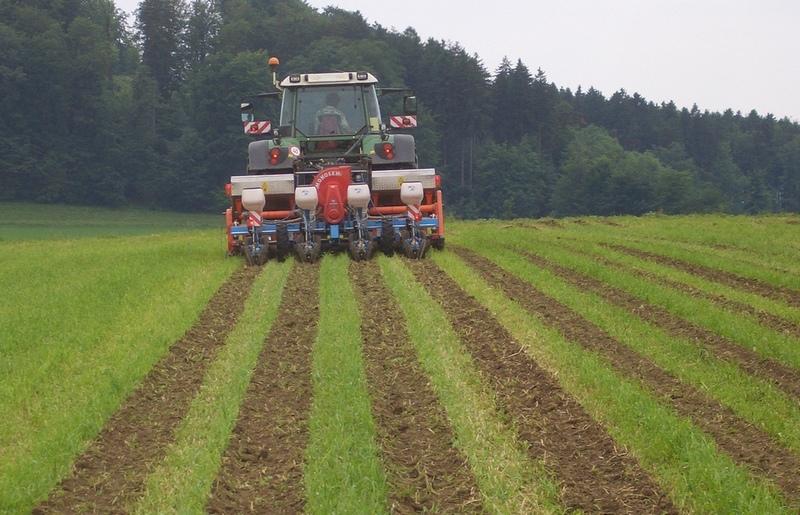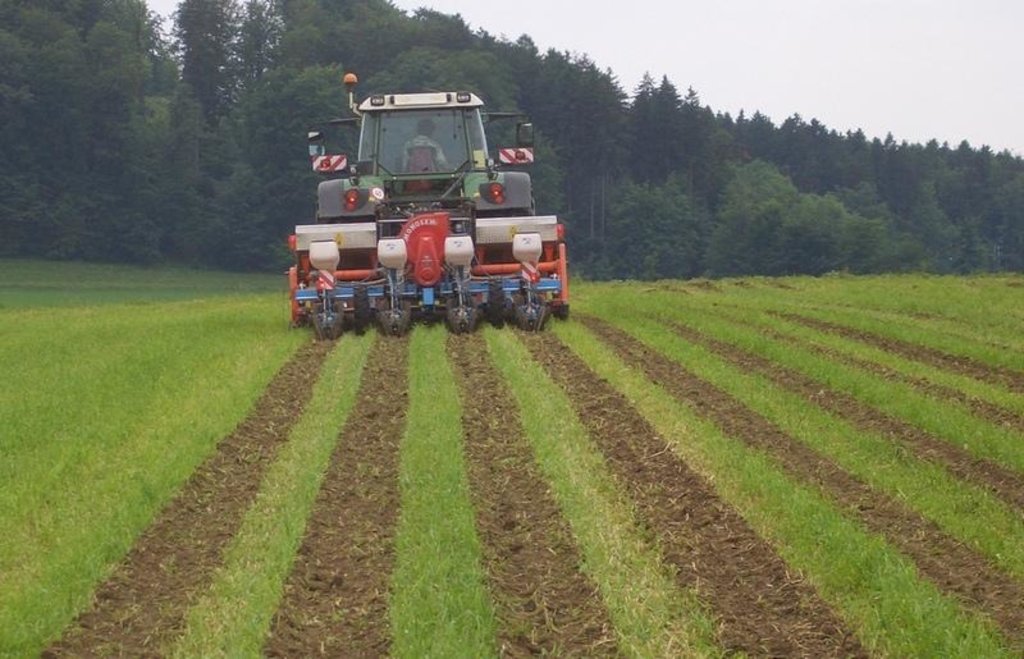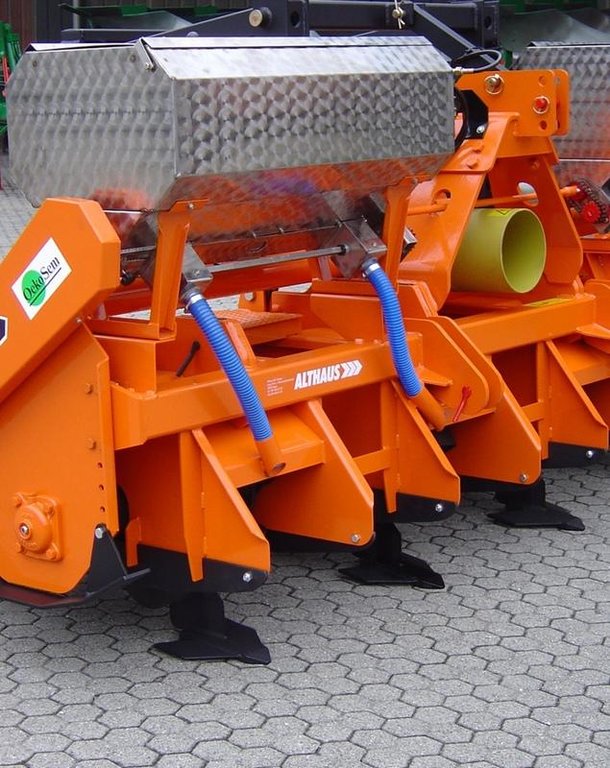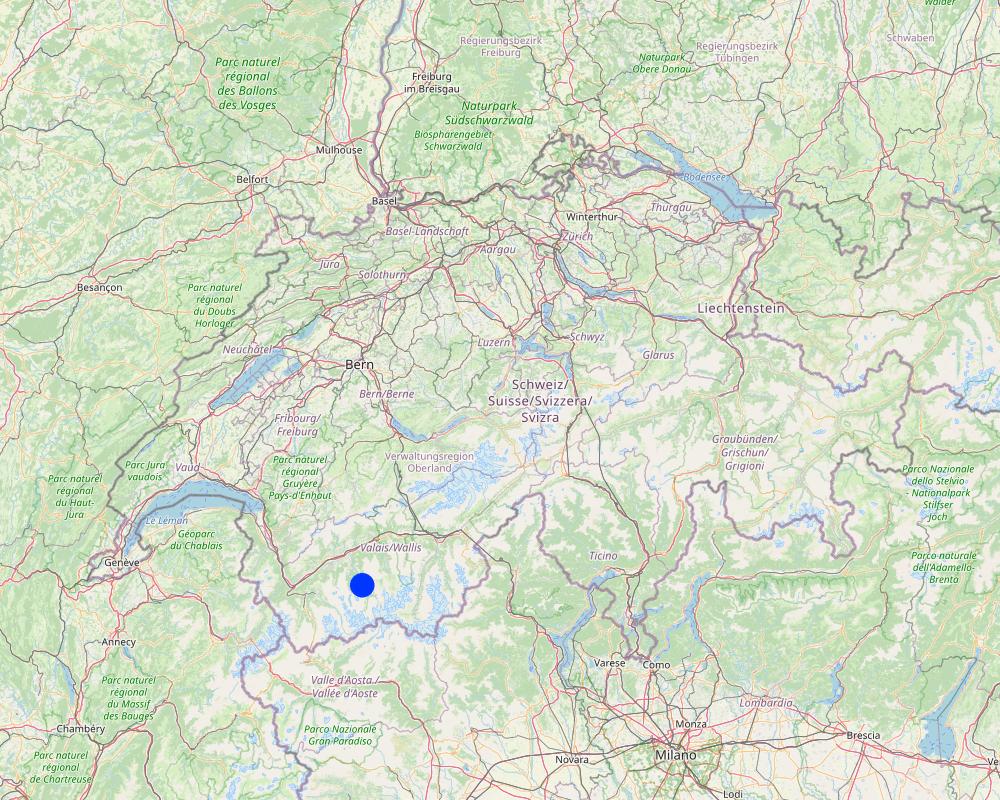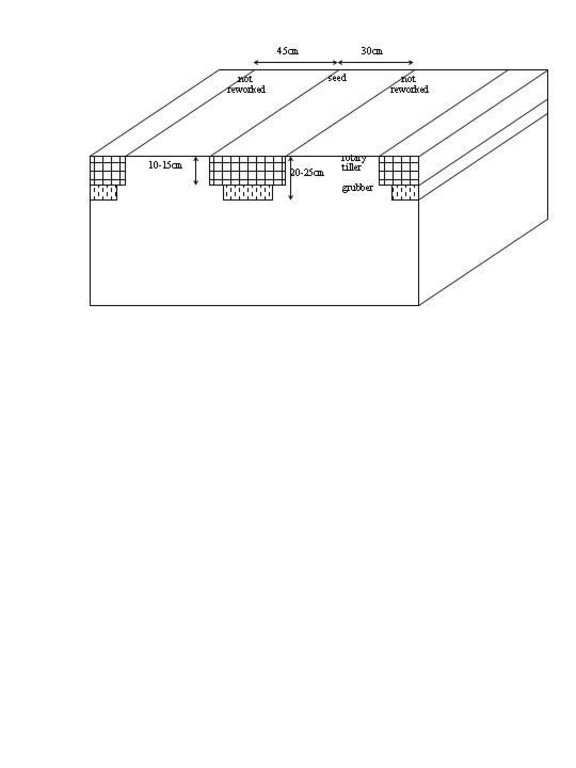Maize strip tillage [Switzerland]
- Creation:
- Update:
- Compiler: Joana Eichenberger
- Editors: Unknown User, Tatenda Lemann, Maria Eliza Turek
- Reviewers: Alexandra Gavilano, Fabian Ottiger, Joana Eichenberger
Streifenfrässaat (German)
technologies_1006 - Switzerland
View sections
Expand all Collapse all1. General information
1.2 Contact details of resource persons and institutions involved in the assessment and documentation of the Technology
Key resource person(s)
SLM specialist:
Wyler Roman
Center for Development and Environment, University of Berne
Switzerland
land user:
Wyss Beat
Switzerland
Name of project which facilitated the documentation/ evaluation of the Technology (if relevant)
OPtimal strategies to retAIN and re-use water and nutrients in small agricultural catchments across different soil-climatic regions in Europe (OPTAIN)Name of the institution(s) which facilitated the documentation/ evaluation of the Technology (if relevant)
CDE Centre for Development and Environment (CDE Centre for Development and Environment) - Switzerland1.3 Conditions regarding the use of data documented through WOCAT
The compiler and key resource person(s) accept the conditions regarding the use of data documented through WOCAT:
Yes
1.5 Reference to Questionnaire(s) on SLM Approaches (documented using WOCAT)
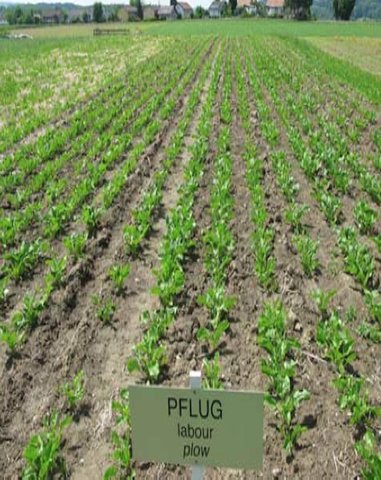
Soil support program for conservation agriculture [Switzerland]
Through the soil support program land users get subsidies for applying conservation technologies on their fields during a period of 6 years.
- Compiler: Deborah Niggli
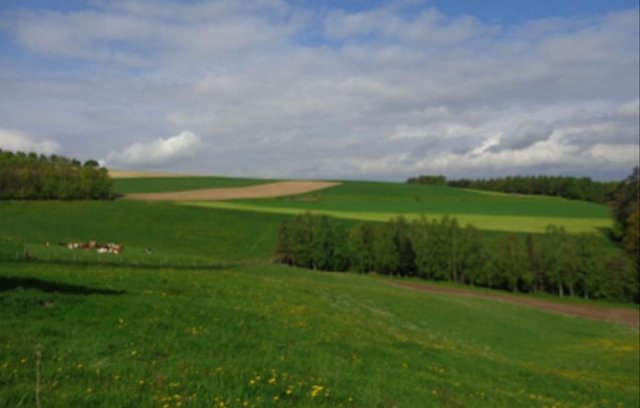
Direktzahlungssystem [Switzerland]
Finanzielle Leistungen des Bundes um den Ertragsverlust, den eine Kultur für den Bauern bringt, auszugleichen. Das Direktzahlungssystem führt gewissermassen zu einer 'Vergünstigung des Produkts' für den Konsumenten.
- Compiler: Deborah Niggli
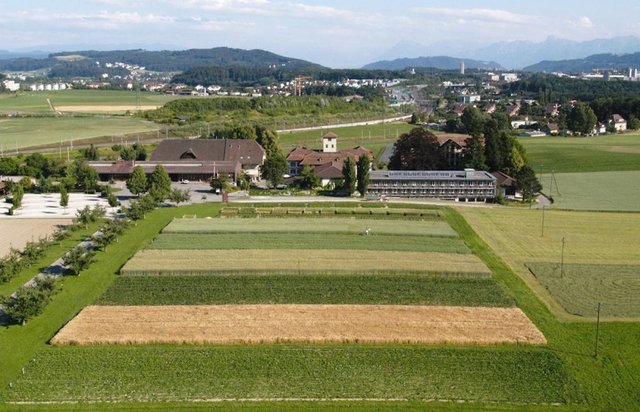
Förderprogramm Boden [Switzerland]
Mit dem Förderprogramm Boden des Kantons Bern erhalten beteiligte Landnutzer Direktzahlungen für die Anwendung von bodenkonservierenden Anbauverfahren auf ihren landwirtschaftlichen Feldern. Das Projekt hat eine Dauer von 6 Jahren.
- Compiler: Deborah Niggli
2. Description of the SLM Technology
2.1 Short description of the Technology
Definition of the Technology:
A cropping system for maize which reduces the reworking of the soil to the stripes, in which the seeds are planted.
2.2 Detailed description of the Technology
Description:
Maize strip tillage is a mixture between no tillage and conventional agriculture. The reworking of the soil greatly reduced. Instead of ploughing and harrowing a special rotary tiller including a grubber is being used. The working depht of the rotary tiller is 10-15cm, the grubber reaches to 20-25cm depht. The machine reworks the soil on stripes of 30cm width. This is where the seeds are planted. In between there are stripes of 45cm width, which are left untouched.
In Switzerland farms usually are small. A major part of the arable land is used to produce fodder. (For example maize, grain, fodder beet)
Usually maize strip tillage is being used to avoid soil erosion or for economical reasons. Compared to conventional agriculture several working steps can be saved. The reworking of the soil, manuring, seeding and applying of herbicides can be done at once.
Since the machine is expensive and a strong tractor is needed, farmers usually don’t buy it on their own. In most cases a contractor will be tasked to do this work. Of course this is not for free. But since several working step are saved, there is more time left to do other work (6.5h/ha).
The reduced reworking of the soil holds remarkable ecological advantages. Occurrence of erosion is very seldom, because the stripes covered by plant residual significantly reduce the speed of surface water. To increase this effect, the stripes are laid along the height countours, if possible. Since the soil structure is not disturbed in the stripes between the seeds, the risk of compaction is reduced there. For that reason maize strip tillage is often used before potatoes in a crop rotation. This is a crop that is very sensitive to soil compaction.
The technique brings along an ecological disadvantage, too. Before sowings the precedent crop needs to be treated with a total herbicide (glyphosat) to avoid unwanted competition. Only in wet areas, where there is enough water available it is possible to not use glyphosat. Also in long time studies, residues of glyphosat could not be detected in the soil. But if ever weeds will develop a resitance against it, that would certainly be a major problem.
The enhanced risk of crop loss is another disadvantage of the technology. In conventional agriculture the soil is left to dry for a few days after ploughing. maize strip tillage does not hold that possibility. If the conditions are wet, risk of crop failure can be a problem. However, if conditions are good (dry enough), both quality and crop yield are similar to conventional agriculture.
2.3 Photos of the Technology
2.5 Country/ region/ locations where the Technology has been applied and which are covered by this assessment
Country:
Switzerland
Region/ State/ Province:
Kanton Solothurn
Further specification of location:
Oberramsern
Comments:
The portraited farmer is working as a contractor and is applying the technology on about 0.8km2. Currently only 1ha of his own land is used for maize.
Map
×2.6 Date of implementation
If precise year is not known, indicate approximate date:
- 10-50 years ago
2.7 Introduction of the Technology
Specify how the Technology was introduced:
- through land users' innovation
Comments (type of project, etc.):
The technology was developed some 12years ago by the designer and contractor Walter Witzig supported by researchers from Forschungsanstalt Reckenholz-Tänikon.
3. Classification of the SLM Technology
3.1 Main purpose(s) of the Technology
- reduce, prevent, restore land degradation
3.2 Current land use type(s) where the Technology is applied

Cropland
- Annual cropping
- Perennial (non-woody) cropping
- hay
Annual cropping - Specify crops:
- cereals - maize
Number of growing seasons per year:
- 1
Specify:
Longest growing period in days: 240Longest growing period from month to month: Mar - Oct
Comments:
Major land use problems (land users’ perception): Soil erosion by water and soil compaction.
3.4 Water supply
Water supply for the land on which the Technology is applied:
- rainfed
3.5 SLM group to which the Technology belongs
- cross-slope measure
3.6 SLM measures comprising the Technology

agronomic measures
- A1: Vegetation/ soil cover
Comments:
Main measures: agronomic measures
Type of agronomic measures: contour planting / strip cropping, minimum tillage
3.7 Main types of land degradation addressed by the Technology

soil erosion by water
- Wt: loss of topsoil/ surface erosion
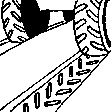
physical soil deterioration
- Pc: compaction

biological degradation
- Bc: reduction of vegetation cover
- Bl: loss of soil life
Comments:
Main type of degradation addressed: Wt: loss of topsoil / surface erosion, Pc: compaction, Bc: reduction of vegetation cover
Secondary types of degradation addressed: Bl: loss of soil life
Main causes of degradation: crop management (annual, perennial, tree/shrub) (too deep and too intensive reworking of the soil.), Heavy / extreme rainfall (intensity/amounts), education, access to knowledge and support services (Tradition. Most people do not question tillage.), crop management (annual, perennial, tree / shrub) (too heavy machinery used under wet conditions.)
3.8 Prevention, reduction, or restoration of land degradation
Specify the goal of the Technology with regard to land degradation:
- prevent land degradation
- reduce land degradation
Comments:
Main goals: prevention of land degradation
Secondary goals: mitigation / reduction of land degradation
4. Technical specifications, implementation activities, inputs, and costs
4.1 Technical drawing of the Technology
Technical specifications (related to technical drawing):
The rotary tillers working depth is 10-15cm. The grubber reaches to 20-25cm depth. This is to obtain a loose soil structure. Manure is brought into the soil while tilling.
Immediately after that the seeds are brought into the soil. Finally a selective herbicide can be sprayed. Stripes of 45cm width are not reworked and help to avoid soil erosion and compaction.
Technical knowledge required for field staff / advisors: moderate
Technical knowledge required for land users: moderate
Main technical functions: improvement of ground cover, improvement of topsoil structure (compaction)
Secondary technical functions: control of raindrop splash, improvement of surface structure (crusting, sealing), increase of infiltration, increase / maintain water stored in soil
Contour planting / strip cropping
Material/ species: Maize
Minimum tillage
Remarks: The stripes are laid along the contours
Author:
Roman Wyler, Bern, Switzerland
4.2 General information regarding the calculation of inputs and costs
other/ national currency (specify):
Swiss Franc
If relevant, indicate exchange rate from USD to local currency (e.g. 1 USD = 79.9 Brazilian Real): 1 USD =:
1.13
4.3 Establishment activities
| Activity | Timing (season) | |
|---|---|---|
| 1. | Buy a "Streifenfräse" | |
| 2. | Buy a tractor |
4.4 Costs and inputs needed for establishment
| Specify input | Unit | Quantity | Costs per Unit | Total costs per input | % of costs borne by land users | |
|---|---|---|---|---|---|---|
| Equipment | Streifenfräse | Machine | 1.0 | 42000.0 | 42000.0 | 100.0 |
| Equipment | Tractor | Machine | 1.0 | 115000.0 | 115000.0 | 100.0 |
| Total costs for establishment of the Technology | 157000.0 | |||||
| Total costs for establishment of the Technology in USD | 138938.05 | |||||
Comments:
Duration of establishment phase: 0 month(s)
4.5 Maintenance/ recurrent activities
| Activity | Timing/ frequency | |
|---|---|---|
| 1. | application of glyphosat (total herbicide) | 1 per growing period |
| 2. | tillage of stripes including seeding, manuring, spraying of herbicide | 1 per growing period |
4.6 Costs and inputs needed for maintenance/ recurrent activities (per year)
| Specify input | Unit | Quantity | Costs per Unit | Total costs per input | % of costs borne by land users | |
|---|---|---|---|---|---|---|
| Labour | tillage of stripes, seeding, | ha | 1.0 | 393.0 | 393.0 | 100.0 |
| Labour | appliance of total herbicide | ha | 1.0 | 88.0 | 88.0 | 100.0 |
| Fertilizers and biocides | Biocides | ha | 1.0 | 53.0 | 53.0 | 100.0 |
| Total costs for maintenance of the Technology | 534.0 | |||||
| Total costs for maintenance of the Technology in USD | 472.57 | |||||
Comments:
Crop yield is about the same as in conventional cropping systems. The cost to apply the technology are about $410 per ha. It takes about 2 working hours per ha. In addition the glyphosat needs to be applied, which accounts for $150 or 0.75h of work. The following worksteps are not needed anymore (working hours, costs when tasking a contractor excl. material): Ploughing (1.25h, $260), harrowing (1.25h, $180), conventional seeding (1h, $100), manuring (1h, $50), applying of herbicides (0.75h, $90). In total about $130 and 4 hours of work can be saved per ha. In some cantons Streifenfrässaat is also subsidised. In the canton of bern this accounts for $420 per ha and year for the first 5 years of appliance. The costs for manure, herbicides, seeds are not included since they are the same as in conventional agriculture.
4.7 Most important factors affecting the costs
Describe the most determinate factors affecting the costs:
The machine is very expensive. In addition a strong tractor is needed (ca. 150hp). Thats why most farmer task a contractor with the seeding. In this case no initial investment needs to be done. The machine in this case study is used for about 60ha per year. A bigger workload would be possible.
5. Natural and human environment
5.1 Climate
Annual rainfall
- < 250 mm
- 251-500 mm
- 501-750 mm
- 751-1,000 mm
- 1,001-1,500 mm
- 1,501-2,000 mm
- 2,001-3,000 mm
- 3,001-4,000 mm
- > 4,000 mm
Agro-climatic zone
- sub-humid
Thermal climate class: temperate
5.2 Topography
Slopes on average:
- flat (0-2%)
- gentle (3-5%)
- moderate (6-10%)
- rolling (11-15%)
- hilly (16-30%)
- steep (31-60%)
- very steep (>60%)
Landforms:
- plateau/plains
- ridges
- mountain slopes
- hill slopes
- footslopes
- valley floors
Altitudinal zone:
- 0-100 m a.s.l.
- 101-500 m a.s.l.
- 501-1,000 m a.s.l.
- 1,001-1,500 m a.s.l.
- 1,501-2,000 m a.s.l.
- 2,001-2,500 m a.s.l.
- 2,501-3,000 m a.s.l.
- 3,001-4,000 m a.s.l.
- > 4,000 m a.s.l.
5.3 Soils
Soil depth on average:
- very shallow (0-20 cm)
- shallow (21-50 cm)
- moderately deep (51-80 cm)
- deep (81-120 cm)
- very deep (> 120 cm)
Soil texture (topsoil):
- medium (loamy, silty)
- fine/ heavy (clay)
Topsoil organic matter:
- high (>3%)
If available, attach full soil description or specify the available information, e.g. soil type, soil PH/ acidity, Cation Exchange Capacity, nitrogen, salinity etc.
Soil fertility is high
Soil drainage/infiltration is good
Soil water storage capacity is high
5.4 Water availability and quality
Ground water table:
5-50 m
Water quality (untreated):
good drinking water
Comments and further specifications on water quality and quantity:
Availability of surface water: good, medium ( precipitation maximum in summer )
5.5 Biodiversity
Species diversity:
- medium
5.6 Characteristics of land users applying the Technology
Market orientation of production system:
- commercial/ market
Off-farm income:
- > 50% of all income
Relative level of wealth:
- average
Individuals or groups:
- individual/ household
Level of mechanization:
- mechanized/ motorized
Indicate other relevant characteristics of the land users:
Difference in the involvement of women and men: Ist mostly men that get in touch with the technology since it is mostly them who are using the machines. But decisions about which technology should be used are taken at the household level including both women and men.
Population density: 50-100 persons/km2
Annual population growth: 0.5% - 1%
Off-farm income specification: The farmer interviewed is working for other farmers, too. In general off-farm income is significantly lower.
5.7 Average area of land used by land users applying the Technology
- < 0.5 ha
- 0.5-1 ha
- 1-2 ha
- 2-5 ha
- 5-15 ha
- 15-50 ha
- 50-100 ha
- 100-500 ha
- 500-1,000 ha
- 1,000-10,000 ha
- > 10,000 ha
Comments:
The farmer portraited owns not more than 10ha, he is working for others as a contractor
5.8 Land ownership, land use rights, and water use rights
Land ownership:
- individual, titled
Land use rights:
- individual
Water use rights:
- communal (organized)
5.9 Access to services and infrastructure
health:
- poor
- moderate
- good
education:
- poor
- moderate
- good
technical assistance:
- poor
- moderate
- good
employment (e.g. off-farm):
- poor
- moderate
- good
markets:
- poor
- moderate
- good
energy:
- poor
- moderate
- good
roads and transport:
- poor
- moderate
- good
drinking water and sanitation:
- poor
- moderate
- good
financial services:
- poor
- moderate
- good
6. Impacts and concluding statements
6.1 On-site impacts the Technology has shown
Socio-economic impacts
Production
crop production
Comments/ specify:
steeper hills can be cultivated since the risk for erosion is reduced
fodder quality
risk of production failure
Comments/ specify:
droughts: less water scarcity, intense rain: less erosion but the weather needs to be dryer in spring, since the soil cannot be left to dry between ploughing and seeding
production area
Income and costs
expenses on agricultural inputs
Comments/ specify:
Less worksteps need to be done, income remains the same. But a total herbicide and sometimes a little more manure is needed
diversity of income sources
Comments/ specify:
Since the work is usually outsourced to a contractor, the farmer can use his time for other activities
workload
Comments/ specify:
less worksteps need to be done
Socio-cultural impacts
cultural opportunities
Comments/ specify:
Reduced independence if contractors are tasked
Ecological impacts
Soil
soil cover
soil loss
soil crusting/ sealing
soil compaction
Biodiversity: vegetation, animals
beneficial species
Comments/ specify:
more earthworms
6.2 Off-site impacts the Technology has shown
damage on neighbours' fields
damage on public/ private infrastructure
6.3 Exposure and sensitivity of the Technology to gradual climate change and climate-related extremes/ disasters (as perceived by land users)
Gradual climate change
Gradual climate change
| Season | increase or decrease | How does the Technology cope with it? | |
|---|---|---|---|
| annual temperature | increase | not known |
Climate-related extremes (disasters)
Meteorological disasters
| How does the Technology cope with it? | |
|---|---|
| local rainstorm | well |
| local windstorm | not known |
Climatological disasters
| How does the Technology cope with it? | |
|---|---|
| drought | well |
Hydrological disasters
| How does the Technology cope with it? | |
|---|---|
| general (river) flood | not known |
Other climate-related consequences
Other climate-related consequences
| How does the Technology cope with it? | |
|---|---|
| reduced growing period | not well |
6.4 Cost-benefit analysis
How do the benefits compare with the establishment costs (from land users’ perspective)?
Short-term returns:
negative
Long-term returns:
positive
How do the benefits compare with the maintenance/ recurrent costs (from land users' perspective)?
Short-term returns:
positive
Long-term returns:
positive
Comments:
The farmer portaited bought a machine on his own. If a contractor were tasked short-returns would be positive too.
6.5 Adoption of the Technology
Of all those who have adopted the Technology, how many did so spontaneously, i.e. without receiving any material incentives/ payments?
- 11-50%
Comments:
80% of land user families have adopted the Technology with external material support
Comments on acceptance with external material support: There is the possibility to get subsidies. But resources are limited and therefore not everybody gets them. (See Approach)
20% of land user families have adopted the Technology without any external material support
There is a moderate trend towards spontaneous adoption of the Technology
Comments on adoption trend: The technology is not spreading homogenously. Adoption and acceptance varies very much in different regions. Pioneers play an important role.
6.7 Strengths/ advantages/ opportunities of the Technology
| Strengths/ advantages/ opportunities in the land user’s view |
|---|
|
The number of worksteps is greatly reduced. Thats why money and time can be saved. How can they be sustained / enhanced? Since less work needs to be done, the farmer can concentrate on other activities to enhance income. |
|
Soil structure is improved. Risk of compaction is reduced. How can they be sustained / enhanced? Still heavy machinery should not be used under wet conditions. |
|
Soil erosion is reduced very much. How can they be sustained / enhanced? The technology applies for maize only. Other conservation techniques should be used for other crops. |
| Strengths/ advantages/ opportunities in the compiler’s or other key resource person’s view |
|---|
|
Steeper hills can be cultivated without risking erosion. How can they be sustained / enhanced? the stripes should in general be laid along the contours. |
6.8 Weaknesses/ disadvantages/ risks of the Technology and ways of overcoming them
| Weaknesses/ disadvantages/ risks in the land user’s view | How can they be overcome? |
|---|---|
| Risk of crop failure is enhanced if seeding under too wet conditions. | The time of seeding is critical and should be chosen carefully. If conditions are too wet, ploughing might be a better choice. |
| The machine is very expensive. Single farmers usually cannot afford it. | Cost can be shared with other parties or a contractor can be tasked. |
| In general a total herbicide must be applied before sowing. | The amount of glyphosat should be adapted to the number of weeds. |
| Weaknesses/ disadvantages/ risks in the compiler’s or other key resource person’s view | How can they be overcome? |
|---|---|
| Reworking of the soil is still intense. | |
| A powerful tractor is needed. Fuel consumption is still high. |
7. References and links
7.1 Methods/ sources of information
7.2 References to available publications
Title, author, year, ISBN:
report on DVD: von Bauern für Bauern
Available from where? Costs?
www.vonbauernfuerbauern.ch CHF 20.-
Links and modules
Expand all Collapse allLinks

Soil support program for conservation agriculture [Switzerland]
Through the soil support program land users get subsidies for applying conservation technologies on their fields during a period of 6 years.
- Compiler: Deborah Niggli

Direktzahlungssystem [Switzerland]
Finanzielle Leistungen des Bundes um den Ertragsverlust, den eine Kultur für den Bauern bringt, auszugleichen. Das Direktzahlungssystem führt gewissermassen zu einer 'Vergünstigung des Produkts' für den Konsumenten.
- Compiler: Deborah Niggli

Förderprogramm Boden [Switzerland]
Mit dem Förderprogramm Boden des Kantons Bern erhalten beteiligte Landnutzer Direktzahlungen für die Anwendung von bodenkonservierenden Anbauverfahren auf ihren landwirtschaftlichen Feldern. Das Projekt hat eine Dauer von 6 Jahren.
- Compiler: Deborah Niggli
Modules
No modules


